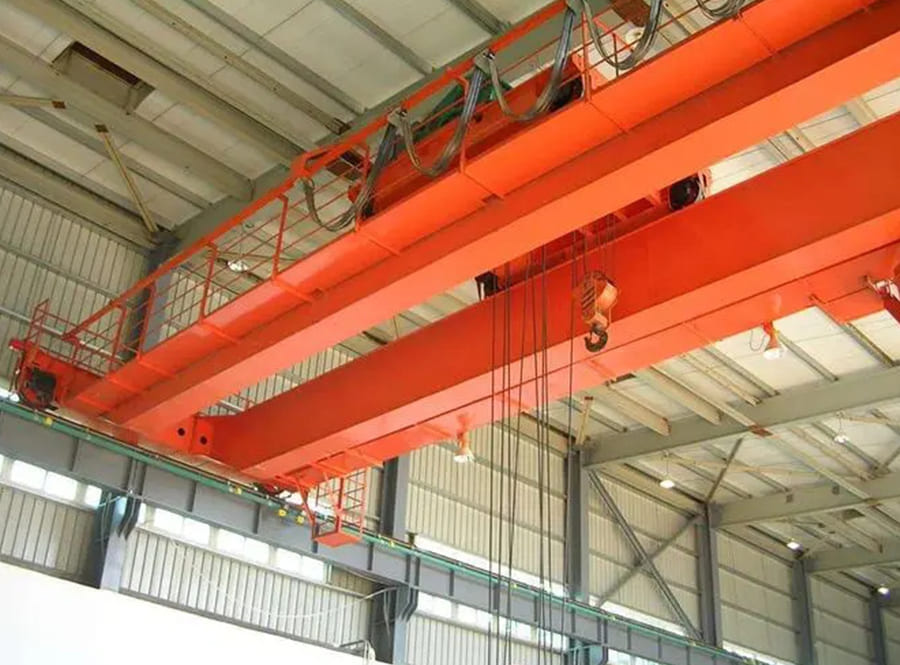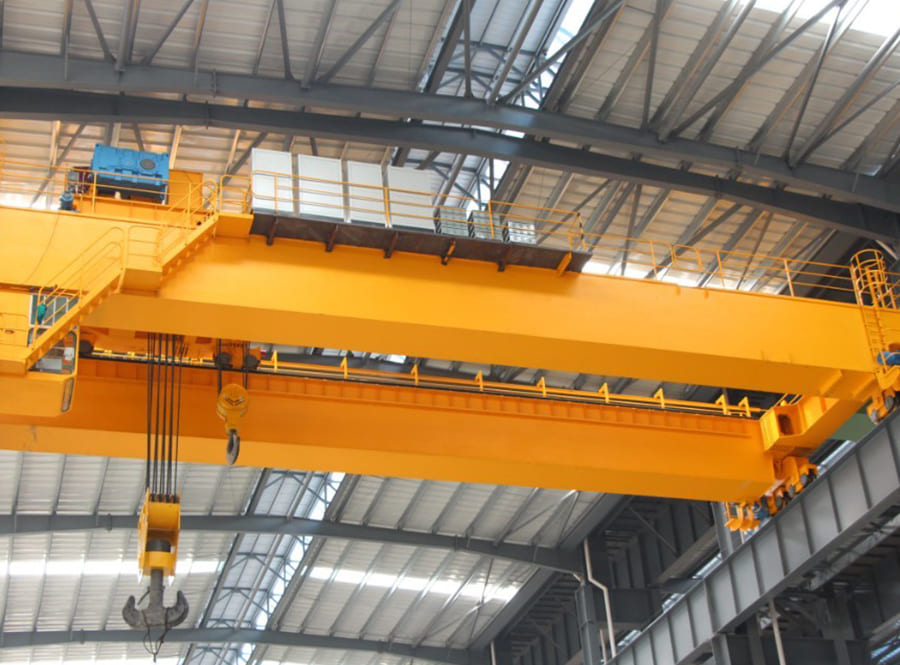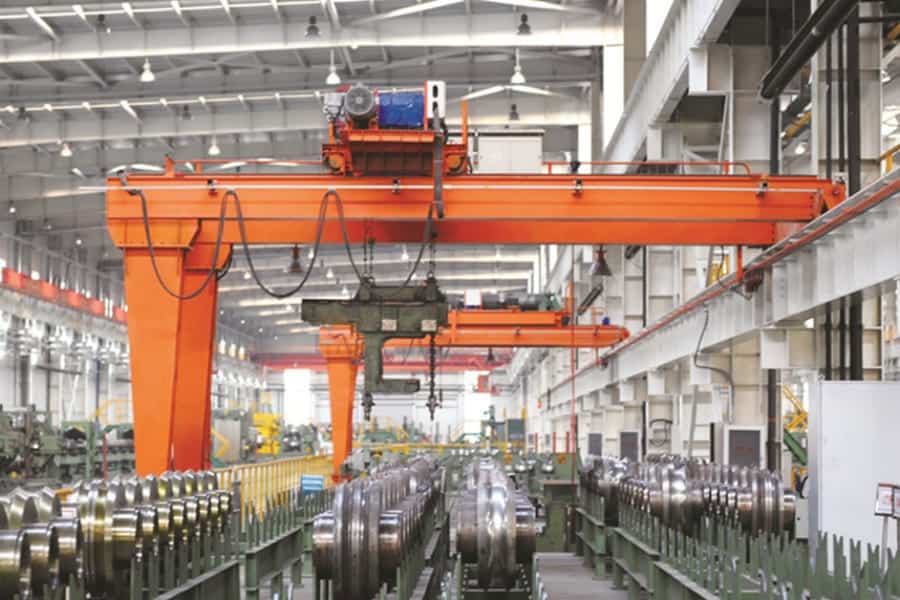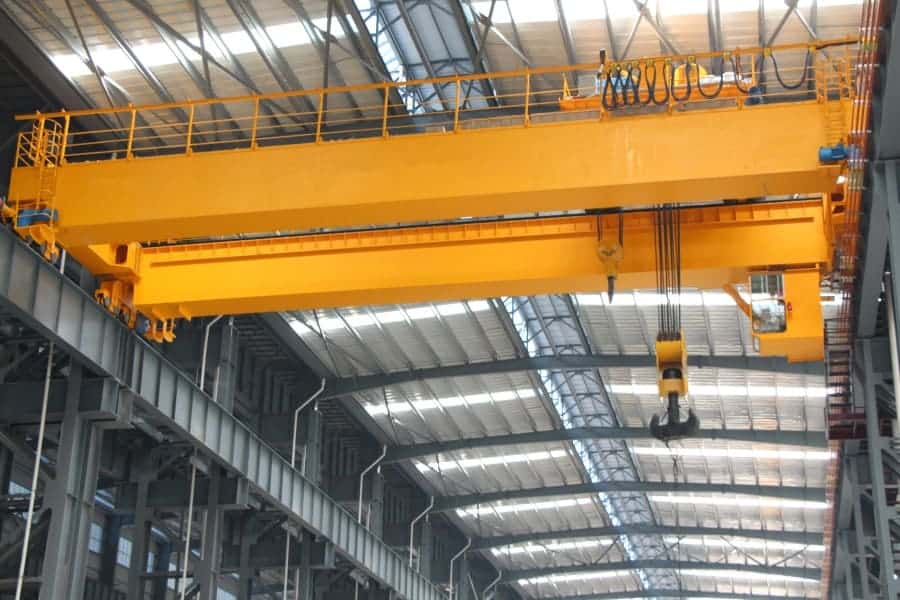We often see some double-girder crane models such as QD16/3.2. 16 and 3.2 both have lifting capacity. One is the main hook and the other is the auxiliary hook. What is the auxiliary hook of the bridge crane used for? What is the difference between hooks? What is the role of auxiliary hooks when lifting heavy objects? These are the questions many people have.

The main hook of overhead bridge crane for sale is the main hook, which has the characteristics of large lifting capacity and slow lifting speed. Most of the work of the crane is done by the main hook, especially when lifting heavy objects exceeding the rated lifting capacity of the auxiliary hook. For safety reasons, it can only be lifted by the main hook; the auxiliary hook plays an auxiliary role and can also be used alone Use to lift heavy objects. The lifting speed is faster than the main hook, which can improve the lifting efficiency of light goods. However, the lifting capacity is lower than that of the main hook, about 1/5~1/3 of the main hook. Generally, when the lifting weight is light and the speed requirement is high, using an auxiliary hook is a better choice.
The rated lifting capacity of the double-girder crane is mainly the lifting capacity of the hook. The total weight of the lifted materials cannot exceed the maximum lifting capacity of the main hook, so it is not suitable for overload lifting. There are two points to note when using the main hook: 1. The main hook and the auxiliary hook are interchangeable. When the heights of the two hooks are similar, the crane should operate separately to avoid collision between the two hooks. Secondly, in principle, it is not recommended to lift two objects with two hooks respectively. Non-working hooks should be raised to a height close to the limit position, and no wire ropes should be hung on the hooks.
The working levels of cranes are divided into 8 levels from A1 to A8: light (A1-A3), intermediate (A4, A5), heavy (A6, A7), and extra heavy (A8).
The basic parameters of the new overhead crane are indicators of lifting equipment performance and technical economy, mainly including: crane Q (t), span L (m), lifting height H (m), movement speed u (m/min) and work Level, etc., the operation and maintenance of the crane are directly related to these basic parameters. Unclear or vague definitions and concepts of the basic parameters of the crane will lead to operations or errors that violate regulations and failure to meet maintenance technical requirements.
1. Lifting capacity of national overhead cranes
The lifting capacity refers to the maximum lifting weight allowed by the lifting machinery under normal circumstances, represented by the symbol Q, and the unit is tons (t). The lifting capacity usually refers to the rated lifting capacity of the lifting equipment, for example, 10t Crane means that the rated lifting capacity allowed by the equipment under normal use conditions is 10t.
The rated lifting capacity of the crane does not include the weight of inseparable spreaders such as hooks and rings, but includes the weight of separable spreaders such as grab buckets, electromagnetic disks, tanks and steel drums.
Cranes with larger lifting capacity often have two sets of lifting mechanisms. The one with large lifting capacity is called the main hook, and the one with small lifting capacity is called the auxiliary hook. The lifting capacities of the main and auxiliary hooks are usually separated by diagonal lines, for example, 20t/ 5t means that the maximum lifting weight of the main hook is 20t, and the maximum lifting weight of the auxiliary hook is 5t.

2. Bridge crane span
The distance between the center lines of the two rails on the operating track of the overhead crane trolley is called the span of the crane, represented by the symbol L, and the unit is m.
The span of the crane is determined by the span of the factory building where the crane is installed, and the relationship is as follows:
L=S-2d where S—factory span, m;
d—The distance between the longitudinal positioning axis of the main body on both sides of the factory building and the center line of the crane track, m.
The crane span value may adopt non-standard span values other than those listed in the table under specified circumstances. For the selection of two spans of 2.3~50t cranes, when a safety passage is required on the factory beam, the span L value of the crane shall be selected according to the 7~31m series, otherwise it shall be selected according to the 7.5~31.5m series.
3. Lifting height of bridge crane
The vertical distance between the z-high and z-low working positions of the crane spreader is called the lifting range D of the crane (D=H+h).
When there is no descending depth, the lifting range D is equal to the lifting height H.
The lifting height and lowering depth are measured based on the center of the hook cavity, and for other spreaders (such as grab buckets, etc.), the lowest point in the closed state is used as the benchmark.
4. Working level of bridge crane
The working level of an overhead crane is a comprehensive parameter that represents the basic capabilities of the crane. Users can choose the appropriate working level crane according to the process requirements to achieve both practical and economical purposes.
The working level of the bridge crane is divided according to the utilization level and load status of the crane. The working level of the crane is divided into 8 levels, namely A1~A8.
The load state of the crane indicates the light degree of the load on the crane, see Table 1-5. The load state of the crane is divided into 4 levels from Q1 to Q4 according to the nominal load spectrum coefficient.
The utilization level of bridge cranes is divided according to the total number of working cycles N within the crane’s design life cycle, and is divided into 10 levels.
The working level of the metal structure and other mechanisms of the bridge crane is the basis for the design of the crane and will not be discussed here.
When using and maintaining cranes, you must pay attention to the working level of the overhead beam crane. The working levels of cranes are different, and the parts and electrical devices of each mechanism are also different. If a light-level crane is used as a heavy-level crane, malfunctions will occur. Even cause accidents. The working level and lifting capacity of a single girder bridge crane are two completely different concepts. If the lifting capacity is large, it is not necessarily heavy-duty, and if the lifting capacity is small, it is not necessarily light-duty. For example, maintenance cranes in pump rooms, air compressor stations, and hydropower stations may have a large lifting capacity, but are used very little, so they are all light-duty cranes. The lifting capacity of some cranes in thermal processing workshops or assembly workshops is not very large, but due to busy work and long use time, they are classified as heavy-duty. Therefore, after understanding the working level of the crane, the use and maintenance personnel should reasonably according to their work level. Carry out operation and maintenance according to the level to avoid damage accidents caused by exceeding its working level.





















